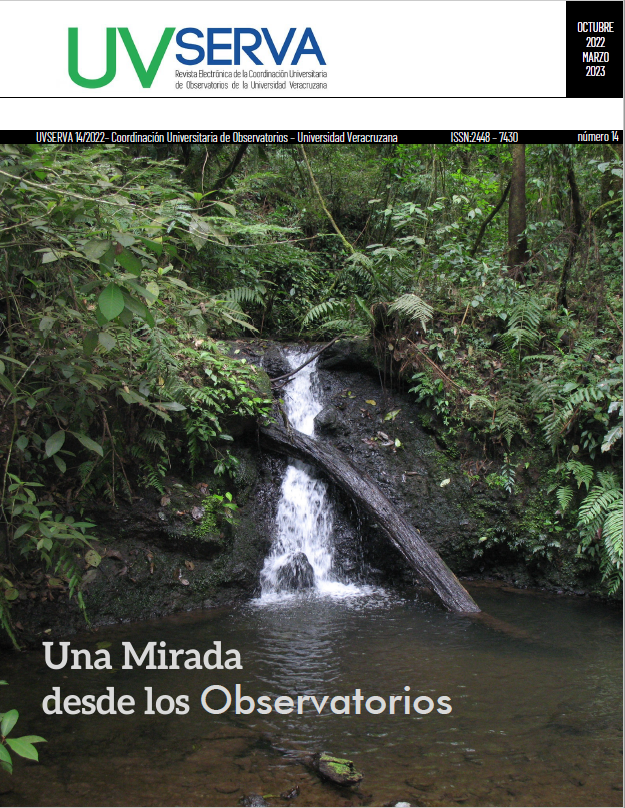Abstract
In order to generate useful information for the coffee production sector, as part of the activities of the Veracruz Coffee Observatory (OBSERVA-CAFE), the estimation of different indices is made to know the environmental conditions in which coffee cultivation is developed and to help producers make decisions regarding the management practices implemented in their production systems. in this sense, from the determination of aridity indices on a monthly scale using the De Martonne Index, water conditions were evaluated, with data measured in the field, in a coffee agroforestry system; these conditions were compared with the average water conditions, determined by the same index with the average climatic variables (1985-2018) of the Briones station (30452) of the National Meteorological Service (SMN).
References
Amarasinghe, U. A., Hoanh, C. T., D’haeze, D., & Hung, T. Q. (2015). Toward sustainable coffee production in Vietnam: More coffee with less water. Agricultural Systems, 136, 96–105. https://doi.org/10.1016/j.agsy.2015.02.008
Cannavo, P., Sansoulet, J., Harmand, J. M., Siles, P., Dreyer, E., & Vaast, P. (2011). Agroforestry associating coffee and Inga densiflora results in complementarity for water uptake and decreases deep drainage in Costa Rica. Agriculture, Ecosystems and Environment, 140(1–2), 1–13. https://doi.org/10.1016/j.agee.2010.11.005
Chemura, A., Mutanga, O., & Dube, T. (2017). Remote sensing leaf water stress in coffee (Coffea arabica) using secondary effects of water absorption and random forests. Physics and Chemistry of the Earth, 100, 317–324. https://doi.org/10.1016/j.pce.2017.02.011
Cohen-Manrique, Carlos S., Burbano-Bustos, Andrea F., Salgado-Ordosgoitia, Rodrigo D., & Merlano-Porto, Rafael H. (2020). Control de riego en cultivos de ahuyama en Sincelejo, Sucre (Colombia) gestionados a través del Internet de las Cosas. Información tecnológica, 31(5), 79-88. https://dx.doi.org/10.4067/S0718-07642020000500079
Harmand, J. M., Ávila, H., Dambrine, E., Skiba, U., De Miguel, S., Renderos, R. V., Oliver, R., Jiménez, F., & Beer, J. (2007). Nitrogen dynamics and soil nitrate retention in a Coffea arabica-Eucalyptus deglupta agroforestry system in Southern Costa Rica. Biogeochemistry, 85(2), 125–139. https://doi.org/10.1007/s10533-007-9120-4
Cheval, S., Dumitrescu, A., & Birsan, M. V. (2017). Variability of the aridity in the SouthEastern Europe over 1961–2050. Catena, 151, 74-86.
Lin, B. B. (2010). The role of agroforestry in reducing water loss through soil evaporation and crop transpiration in coffee agroecosystems. Agricultural and Forest Meteorology, 150(4), 510–518. https://doi.org/10.1016/j.agrformet.2009.11.010
Montoanelli, C. J., Sousa, V. H., Baitelle, C. D., Loss, B. J., Monaco, V. P., Ramalho, H. I., Merlo, M. C., Vargas, S. V., Birchler, R., & Zanotti, M. F. (2017). Controlled water stress in uniformity of maturity and productivity of conilon coffee. African Journal of Agricultural Research, 12(3), 192–199. https://doi.org/10.5897/AJAR2016.11995
Ramírez-Builes, V., Jaramillo-Robledo, Á., & Arcila-Pulgarín, J. (2010). Índices para evaluar el estado hídrico en los cafetales. Cenicafé, 61(1), 55–66.
Stojcheska, A. M., Hristov, J., & Surry, Y. (2019). Farm response to climate change: exploratory analysis of Macedonian agriculture using the Ricardian modeling approach. Contributions, Section of Natural, Mathematical and Biotechnical Sciences, 40(1), 105. https://doi.org/10.20903/csnmbs.masa.2019.40.1.135
Troyo, D. E., Mercado, M. G., Cruz, A., Nieto, G. A., Valdez C. R. D., García, J. L., & Murillo, B. (2014). Análisis de la sequía y desertificación mediante índices de aridez y estimación de la brecha hídrica en Baja California Sur, noroeste de México. Investigaciones geográficas, (85), 66-81.
Wang, Q. y Takahashi, H. (1999) A land surface water deficit model for an arid and semiarid region: Impact of desertification on the water deficit status in the Loess Plateau, China. Journal of Climate, 12, 244–257.

This work is licensed under a Creative Commons Attribution-NonCommercial 4.0 International License.
Copyright (c) 2022 Paulo César Parada Molina, Gustavo Ortiz Ceballos, Juan Cervantes Pérez, Carlos Roberto Cerdán Cabrera


